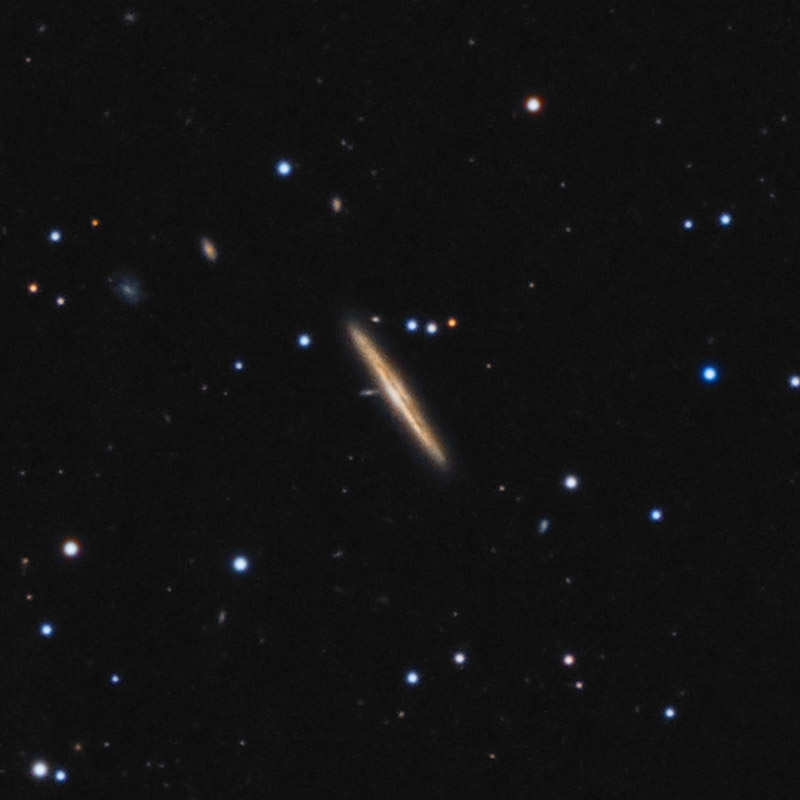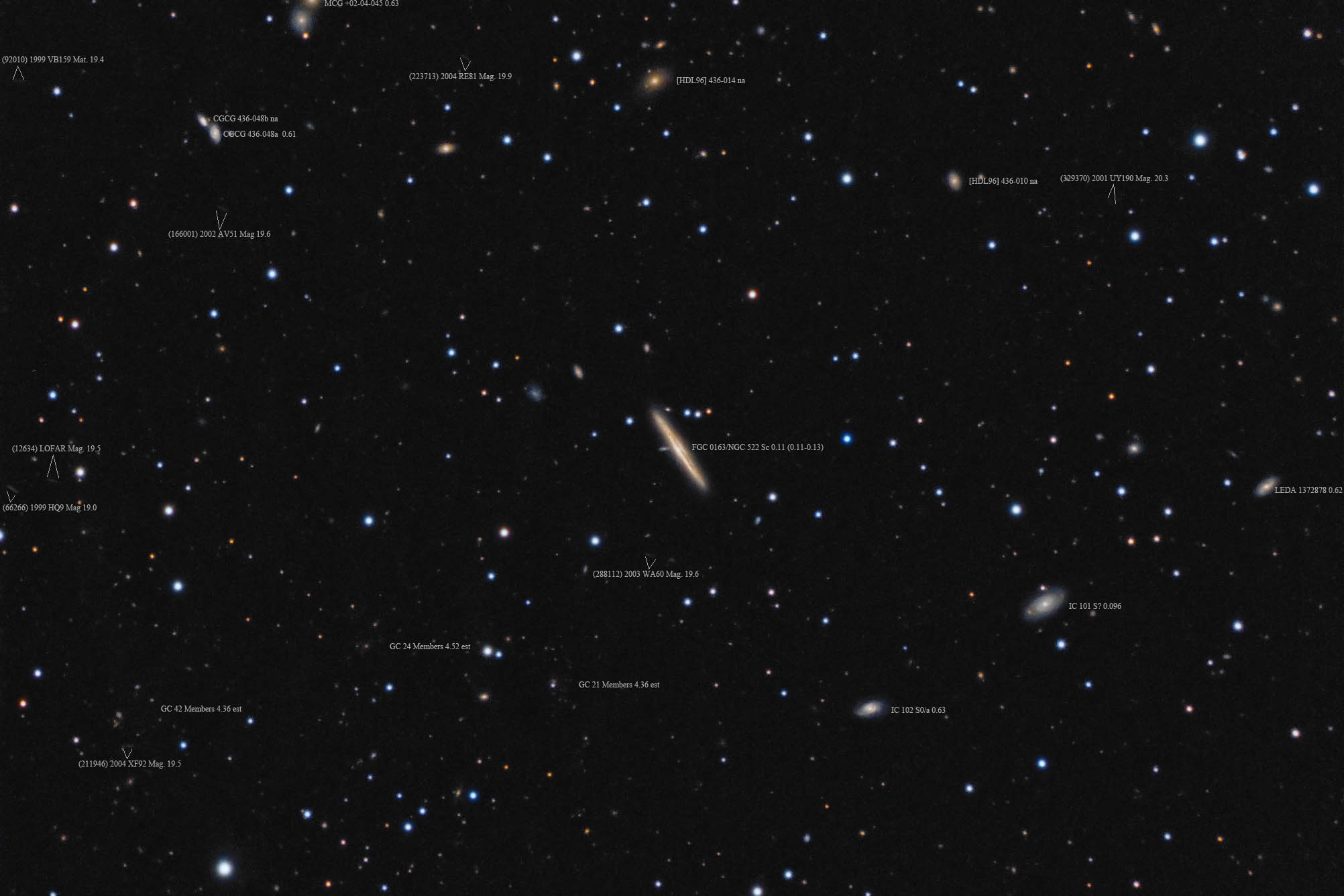Object name: NGC0522Designation(s): NGC0522, IC0101, IC0102, FGC 163/NGC 522 is a flat galaxy in central Pisces about 110 million light-years away by redshift. Other measurements have a mean value of 130 million light-years and median value of 110 million light-years, a rather good agreement. NED lists it as a Sc galaxy while the NGC Project says Sbc:. It is about 80,000 light-years in diameter but less than 11,000 light-years thick. It was discovered by Heinrich d'Arrest on September 25, 1862. There's a tiny, most likely very distant, edge on spiral on its east side. It isn't listed at NED or SIMBAD for some reason. so I can't tell you anything about it.
There are quite a few other galaxies in the image but few are at its approximate distance. IC 101 is its closest neighbor at a redshift of 96 million light-years. It is classed as Sb? and was discovered by Stephane Javelle on December 2, 1893. I calculate its length to be about 45,000 light-years. While appearing only slightly smaller IC 102 is actually much large as it is about 6 times more distant at 630 million light-years. That makes it about 146,000 light-years across, over three times the size of IC 101. It is listed as S0/a and was also discovered by Javelle the same night as he found IC 101. A couple other galaxies have a similar redshift that are therefore all likely members of the same local group.
I've identified all galaxies with redshift data and the brighter ones without such data and a catalog entry that isn't just its sky coordinates. Most only are known by their coordinates and most of the others are only in very obscure catalogs.
The image also contains 8 asteroids, all quite faint which caused me to stretch the image a bit more than I'd normally do to bring them out better. Only one has a common name LOFAR. Yes, it is named for the radio telescope. Its naming citation reads: "LOFAR (LOw-Frequency ARray), a novel radio telescope, proposed by Leiden astronomer George Miley and inaugurated in 2010, consists of tens of thousands of individual low-frequency antennas, distributed over north-western Europe, with its core region in the Netherlands."
But it is the asteroid (288112) 2003 WA60 that interests me. Note how the first half of its trail is a lot brighter than the last half. I can't see that as conditions as the other asteroid trails don't show this wide variance. My first thought was the first half of the trail was atop a distant galaxy or maybe a pair of stars. But this field was taken by the Sloan telescope which goes deeper than I do and it shows nothing at this location. Thus the trail really did have this variation. It seems too sudden for even a highly elongated asteroid to turn from sideways to end on but that's about all I can think of. I suppose a brilliant albedo feature than suddenly went into shadow could do this but I've not heard of any asteroid having such a feature. I'm rather lost for ideas what could cause this. Too further complicate the issue (211946) 2004 XF92, to the lower left, does just the opposite and, even vanishes for part of its trail. The first half of its trail in the second frame is very dim. For the last half, it comes up brighter but not to where it was in the first frame. It then stays at this brightness in the third and fourth frames. These are behaving very strangely indeed.
14" LX200R @ f/10, L=4x10' RGB=2x10', STL-11000XM, Paramount ME Related Designation(s):2MASS J01240856+0955492, 2MASS J01242634+0953117, 2MASS J01244585+0959409, 2MASS J01244592+0959428, 2MASX J01240854+0955500, 2MASX J01242632+0953114, 2MASX J01244585+0959406, 2MFGC 01089, CGCG 0121.5+0940, CGCG 0121.8+0938, CGCG 0122.1+0944, CGCG 436-039, CGCG 436-040, CGCG 436-043, EON J021.191+09.995, FGC 0163, GALEXASC J012408.56+095548.9 , GALEXASC J012426.27+095311.5 , GALEXASC J012445.96+095944.2 , GALEXMSC J012408.57+095548.4 , GALEXMSC J012426.31+095311.6 , GALEXMSC J012446.03+095944.4 , HDCE 0071 NED006, IC 0101, IC 0102, IC0101, IC0102, IRAS 01221+0944, IRAS F01221+0944, LDCE 0085 NED011, LGG 023:[G93] 003, LGG 023:[G93] 009, MCG +02-04-036, MCG +02-04-038, NGC 0522, NGC0522, NSA 129398, NSA 129420, NSA 129458, NVSS J012425+095307, PGC 005147, PGC 005172, PGC 005218, RFGC 0318, UGC 00949, UGC 00954, UGC 00970, USGC U060 NED01, USGC U060 NED09, UZC J012408.6+095550, UZC J012445.9+095940, WBL 042-001, WBL 042-002, WBL 042-003, [HDL96] 436-009, [HDL96] 436-011, [HDL96] 436-013, [M98j] 018 NED10, | | 

